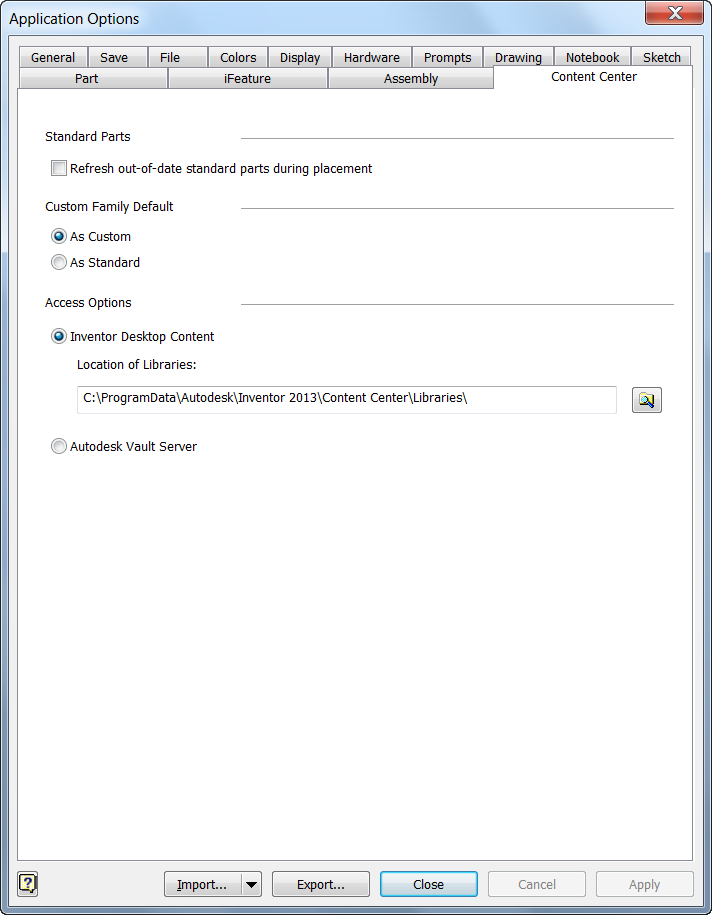
Figure 1
Migrating customized Content Center libraries in Desktop Content
Inventor Desktop Content default location is in C:\ProgramData\Autodesk\Inventor <version>\Content Center\Libraries or C:\Documents and Settings\All Users\Application Data\Autodesk\Inventor <version>\Content Center\Libraries folder. You can changed this default location via Application Options--> Content Center tab. See figure 1.
Follow these steps to migrate customized Content Center library in Desktop Content:
Step 1: Copy your legacy customized Content Center library into Desktop Content location. See the Location of Libraries option in Figure 1.
Step 2: Update the legacy customized Content Center libraries by using the Update Tool in Configure Content Center libraries dialog.
In the project dialog, click [Configure Content Center Libraries] button. The legacy customized Content Center libraries are listed in the Configure Libraries dialog box. Note that the "In Use" column is selected. Click [Update Tool] to migrate. See Figure 2.
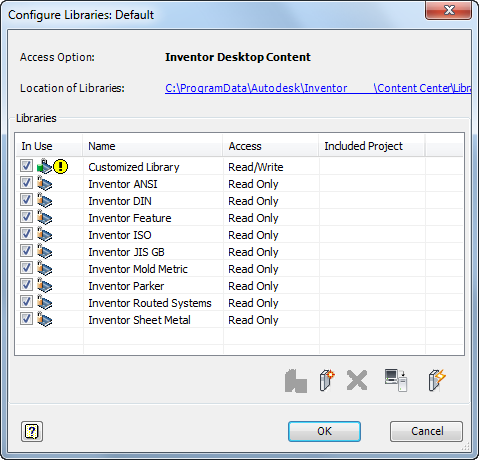
Figure 2
Step 3: In Update Tool dialog, it is the Content Center User Libraries Update Guide. Can click [Next] button step by step to finish custom libraries migration. See figure 3.

Figure 3
The Update Tool dialog box is displayed. Click [Next] - The legacy customized Content Center libraries that will be updated are listed. See Figure 4.
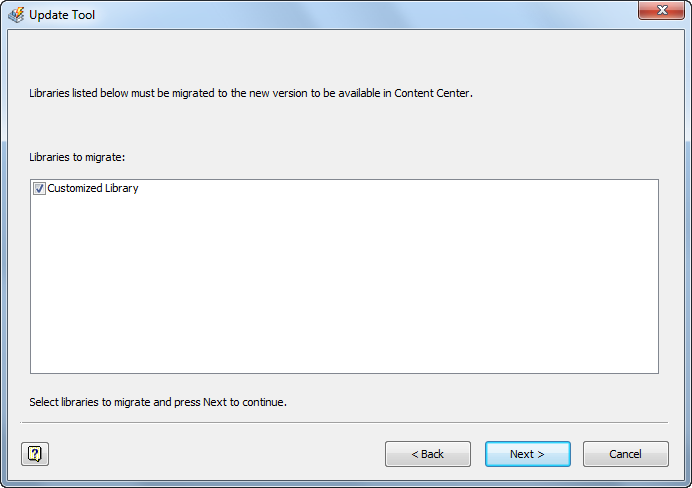
Figure 4
Select the library to update. If more than one user library is out of date, you can select several libraries to be updated in the same process. Then click [Next].
A library analysis is performed and results of the analysis are displayed. If any problems are found, you must solve them to continue. If no problems are found, the Backup options are displayed. Specify a folder to create a backup and click Next. See Figure 5.

Figure 5
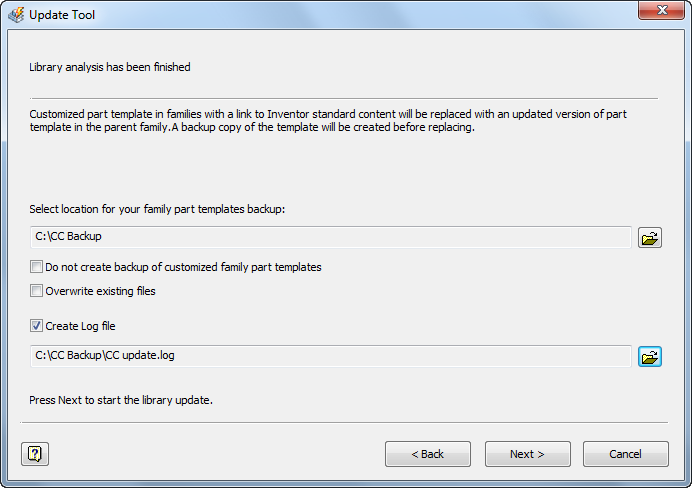
Figure 6
After the process ends, review the Update report. See Figure 7.
Tip (Cross References between Libraries): If there is a cross reference, and you have a user library (UL1) that includes source families for families in user library UL2, and UL2 includes source families for families in user library UL1, you must attach both libraries and run the update tool step by step for UL1 and UL2.
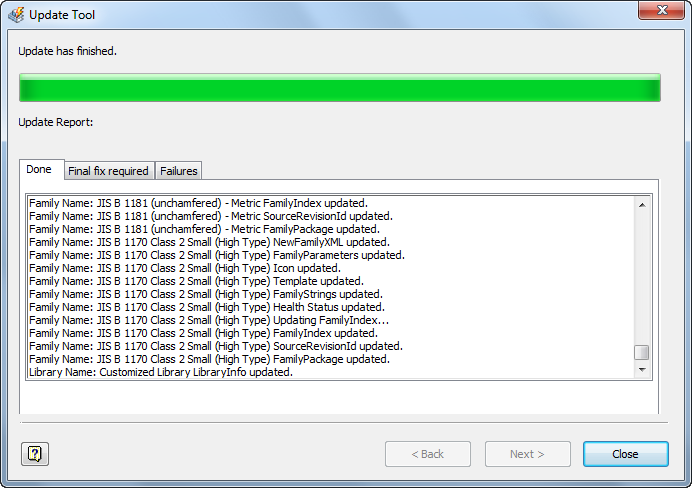
Figure 7
Fix all sick families in the updated library (libraries). Sick families are marked with an icon in the Place from Content Center and Content Center Editor dialog boxes. They can be used in Content Center, but sick family members may cause unexpected problems.
Migrating customized CC library in Vault Server
The migration of the customized CC library is done in two steps. The first step is to migrate the Autodesk Data Management Server (ADMS). The second step is to update the customized CC library to the new version of Inventor and refresh the legacy assemblies.
Perform the following steps to migrate customized CC library in Vault Server:
- Use ADMS Console to create a backup.
- Uninstall the existing ADMS, and then install the new version of ADMS and Inventor.
- Migrate legacy customized CC libraries to the new version of ADMS.
- Copy legacy customized CC libraries to new Inventor partition the ADMS Console.
- Click [Configure Content Center libraries] button in the Inventor project.
- Update legacy customized CC libraries by using Update Tool in Configure Content Center libraries dialog.
- Refresh Content Center parts in legacy assemblies.
Step 1: Use ADMS Console to create a backup
Back up all ADMS data before you upgrade ADMS. Run ADMS Console, and select Tools > Backup from the ADMS Console menu. The Backup tool creates a backup of all libraries and vaults.
Step 2: Uninstall existing ADMS, and then install new version of ADMS and Inventor.
Please refer ADMS and Inventor installation documents for detail information.
Step 3: Migrate legacy Content Center libraries to the new version of ADMS.
Usually it will automated migrate legacy customized CC libraries to the new version of ADMS when you import it or restore backup of old ADMS version.
- Run ADMS Console.
- In the ADMS Console window, expand Libraries, and right-click a library to copy. See Figure 8.
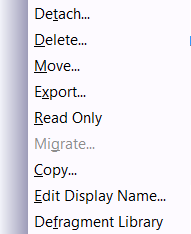
Figure 8
- In the Copy Library dialog box, enter the library name, select Autodesk Inventor 2013 partition, and click OK. The library is copied into Autodesk Inventor 2013 partition. See Figure 9.
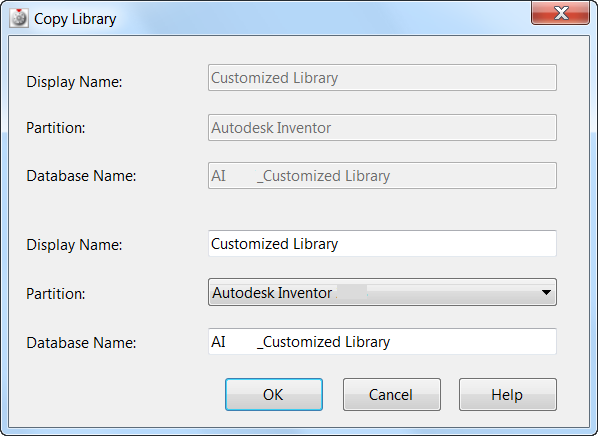
Figure 9
Step 5: Update legacy customized CC libraries by using Update Tool in Configure Content Center libraries dialog.
This step is the same with update legacy customized CC libraries in Desktop Content.